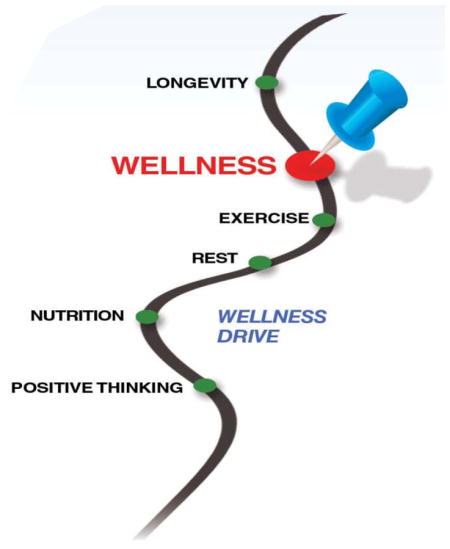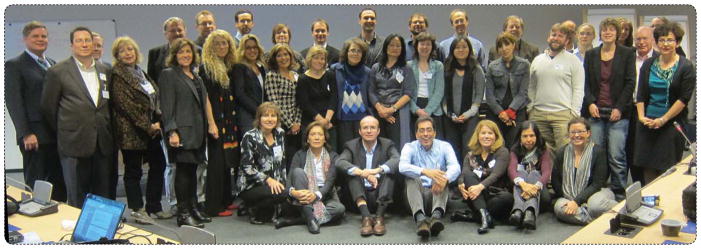Noncommunicable diseases (NCDs)—such as heart disease and stroke, cancer, diabetes, and chronic lung disease—kill more people globally than infectious diseases and are responsible for about two-thirds of deaths worldwide [1]. Six out of the seven most important risk factors for premature death (high blood pressure, high cholesterol, high body mass index, inadequate fruit and vegetable intake, physical inactivity, and excessive alcohol consumption) are related to diet and physical activity (smoking is the seventh). Unhealthy diet and the lack of physical activity are the leading causes of avoidable illness and premature death in Europe. Worldwide, the prevalence of NCDs is expected to increase dramatically (see “Diseases That Break the Bank”).
Our lifestyle choices combined with our social, built, and economic environments influence the way our genes express themselves in our dynamic phenotype and interactively contribute to health or disease [2], [3]. NCDs can, to a large extent, be prevented by following the current health guidelines on diet, alcohol, physical activity, and smoking. Therefore, NCDs are often called lifestyle diseases.
Current thinking still views much of health promotion and prevention as relying on public health awareness campaigns to increase health literacy, on education, and on feedback and support, as well as on policy and regulatory activities to decrease unhealthy behavior (e.g., regarding smoking, intoxicants, package labeling, and urban planning). Health statistics (e.g., [4] and [5]), however, show that the prevalence of NCDs is increasing around the world and that these efforts are only modestly effective in preventing disease and reducing the overall disease burden and health expenditure. Given the number of variables affecting health, it is not surprising that “one size does not fit all,” and evidence shows that current efforts are not enough.
We need novel solutions to prevent disease and promote health as well as to better manage NCDs when they occur. What is needed is a fresh and disruptive approach that centers on individuals and provides them with the knowledge, services, and tools to support everyday health-related behaviors.
Putting people in the center is not a novel idea. For instance, the Chronic Care Model [6], which has been shown to be an effective way to manage chronic diseases, shows that the key actors in health management are informed and activated patients. People’s daily activities in interaction with their medical, social, built, and economic environments contribute to health and disease [2], [3].

Empowering people to manage their health and wellness and, if present, chronic diseases requires that two challenges are met. The first is a disruption in the way health services are delivered and incentivized. The current illness-centered health-care model needs to be replaced with a proactive health and wellness-centered model where people and health-care professionals manage their health and illness (see, e.g., [7]).
The second advance is to empower people to manage their health by developing innovative services and tools that people want and can use that will provide the ability to respond wisely in health-related situations. This is a challenge and requires more research and new scientific paradigms.
A major barrier to behavioral change is that current behavioral theories are not “up to the job” [8]. Most of the numerous theoretical frameworks proposed to characterize behavior and conduct behavioral interventions are static theories in a dynamic world and thus fail when making predictions in the real world. The existing models of individual behavior were developed during the time when data from a citizen could, for the most part, only be collected during the brief interaction that a health professional had with the patient. Community-level models are mostly based on aggregate data and do not capture the complexity of interactions and changes within the community. In real life, behavior is generated through ongoing dynamic, shifting interactions among the individual, the social environment, and the physical environment over time.
We propose that the solution can be found by analyzing and modeling our behavior together with our digital footprints to develop novel tools that help scientists understand behavioral trends and decision making at the individual level and by novel intervention methods capable of addressing the complex, dynamic, real-time nature of behavior and behavioral change.
Our ability to understand, change, and maintain human behavior would benefit greatly from quantitative representations of how behaviors may change as a function of the inputs. Those inputs range from biological responses to stimuli to social influences and environmental contexts to knowledge and guidance from human or electronic coaches. Quantifiable representations of such inputs on behavior and decision making would permit system–theoretical approaches to understand individual’s contextual situation and expected short- and long-term behavior. This would allow the selection of optimal interventions tailored to the situation.
The new approach might be achieved with the following steps:
Harness emerging mobile and ubiquitous digital technologies (sensors, smartphones, Internet of Things, next-generation networks, etc.) to collect comprehensive data sets on personal behavior in context while maintaining the required level of personal privacy and security.
Liberate existing data—not just health or illness data but also data that are already being collected for various business purposes, such as loyalty cards for grocery shopping and other items, credit card records that show our behavior, and mobile phone use and location data.
Use data mining and systems modeling to build predictive models of personal behavior.
Deploy these models combined with knowledge from systems medicine and behavior science to predict and anticipate personal behavior.
Provide users with personalized feedback at opportune moments that they can use in managing their behavior to enhance health (but carefully designed based on the free will of users).
There are several challenges in making these steps a reality. First, can we get access to all data to aggregate and interpret them for behavioral patterns and causal chains? This requires a big data approach based on data mining and dynamic systems modeling. Second, can we use the generated insight to test and validate theories and to use them in building systems that can guide our behavior to healthy choices? Third, can we establish technologies that make value propositions to individuals and other stakeholders that are attractive enough to enable sustainable business models? And finally, some overarching issues to solve are related to privacy, confidentiality, and the ethics of collecting and using personal data in a way that users accept and trust.
Diseases That Break the Bank.
“The worldwide increase of NCDs is a slow-motion disaster. …These are the diseases that break the bank. Left unchecked, these diseases have the capacity to devour the benefits of economic gain. A recent World Economic Forum and Harvard University study estimates that, over the next 20 years, NCDs will cost the global economy more than US$30 trillion, representing 48% of global gross domestic product (GDP) in 2010. NCDs deliver a two-punch blow to development. They cause billions of dollars in losses of national income, and they push millions of people below the poverty line, each and every year” [S1].
- S1.Chan M. Noncommunicable diseases damage health, including economic health. presented at the 2011 United Nations General Assembly. 2011 [Online]. Available: www.who.int/dg/speeches/2011/un_ncds_09_19/en/
This is the background that prompted us to organize in mid-October 2012 in Brussels the International Workshop on New Computationally Enabled Theoretical Models to Support Health Behavior Change and Maintenance (www.behaviorchange.be). The workshop was sponsored by the U.S. National Science Foundation, the European Commission Directorate for Communications Networks, Content, and Technology’s Health and Well-Being Unit, and the U.S. National Institutes of Health’s Office of Behavioral and Social Sciences Research. We invited 30 experts from both the United States and Europe representing a mix of scientific disciplines that will play a role in this emerging transdisciplinary research domain (Figure 1).
FIGURE 1.

Workshop participants gather for a group photo.
The mission of the workshop was threefold: 1) identify and outline strides that need to be made in innovation and scientific discovery related to understanding of human health behavior, behavioral change, and behavior maintenance, 2) enumerate ways to address barriers that may hinder innovation, and 3) propose bold steps that can help us to overcome those barriers. The final outcome of the workshop is a white paper that has been submitted to the sponsoring organizations for consideration in their respective upcoming research agendas and is currently under review for wider publication.
In this issue of IEEE Pulse, we offer part one of a two-part special series of articles that illustrate, through examples, the breadth and depth of the field and highlight the challenges in moving behavioral-change science to the 21st century. The first article, by Nilsen and Pavel, describes the value of using digital technology and the data stemming from it to create empirically based theories of behavioral change based on computational models. The second article, by Hekler et al., describes the many subtle steps and processes that are involved when developing behavioral change interventions and then describes how advances in behavioral science and lessons from engineering and computer science can be used to realize the 21st potential for improving population health via effective behavioral management. Additional articles that address systems modeling of behavioral change and technology-enabled interventions comprise part two of this series, which will run in the November/ December issue of IEEE Pulse.
In summary, we challenge the research community to move the science of behavioral change to the 21st century. The first step in realizing this vision is to engage the scientific, technical, industrial, and health-care communities in addressing these issues in a transdisciplinary fashion. There is increasing interest in this emerging domain, and advances in computerized measurement and Internet-connected devices are leading to movements such as the Quantified Self Movement that may make new types of data accessible at scales not previously possible. The next step is to make intelligent use of such data in creating models based on applications that will longitudinally assist us in the difficult task of managing our health behavior choices.
Contributor Information
Niilo Saranummi, Email: niilo.saranummi@vtt.fi, VTT Technical Research Centre of Finland, Tampere.
Donna Spruijt-Metz, Email: dmetz@usc.edu, University of Southern California.
Stephen S. Intille, Email: S.Intille@neu.edu, Northeastern University
Ilkka Korhonen, Email: ilkka.korhonen@tut.fi, Tampere University of Technology, Finland.
Wendy J. Nilsen, Email: nilsenwj@od.nih.gov, Office of Behavioral and Social Sciences Research, U.S. National Institutes of Health
Misha Pavel, Email: mpavel@nsf.gov, Computer, Informational Systems, and Engineering Department, U.S. National Science Foundation and Northeastern University.
References
- 1.World Health Organization. Non-communicable disease factsheet. 2013 [Online]. Available: www.who.int/mediacentre/factsheets/fs355/en/
- 2.Willett WC. Balancing life-style and genomics research for disease prevention. Science. 2002 Apr;296:695–698. doi: 10.1126/science.1071055. [DOI] [PubMed] [Google Scholar]
- 3.Bousquet J, Anto JM, Sterk PJ, Adcock IM, Chung KF, Roca J, Agusti A, Brightling C, Cambon-Thomsen A, Cesario A, Abdelhak S, Antonarakis SE, Avignon A, Ballabio A, Baraldi E, Baranov A, Bieber T, Bockaert J, Brahmachari S, Brambilla C, Bringer J, Dauzat M, Ernberg I, Fabbri L, Froguel P, Galas D, Gojobori T, Hunter P, Jorgensen C, Kauffmann F, Kourilsky P, Kowalski ML, Lancet D, Pen CL, Mallet J, Mayosi B, Mercier J, Metspalu A, Nadeau JH, Ninot G, Noble D, Öztürk M, Palkonen S, Préfaut C, Rabe K, Renard E, Roberts RG, Samolinski B, Schünemann HJ, Simon HU, Soares MB, Superti-Furga G, Tegner J, Verjovski-Almeida S, Wellstead P, Wolkenhauer O, Wouters E, Balling R, Brookes AJ, Charron D, Pison C, Chen Z, Hood L, Auffray C. Systems medicine and integrated care to combat chronic noncommunicable diseases. Genome Med. 2011;3(7):43. doi: 10.1186/gm259. [DOI] [PMC free article] [PubMed] [Google Scholar]
- 4.OECD. Better life index. 2013 [Online]. Available: www.oecdbetterlifeindex.org/topics/health/
- 5.Centers for Disease Control. Overweight and obesity. 2013 [Online]. Available: www.cdc.gov/obesity/data/adult.html.
- 6.Wagner EH, Austin BT, Von Korff M. Organizing care for patients with chronic illness. Milbank Q. 1996;74(4):511–544. [PubMed] [Google Scholar]
- 7.Christensen CM, Grossman JH, Hwang J. The Innovator’s Prescription: A Disruptive Solution for Health Care. New York: McGraw-Hill; 2009. [Google Scholar]
- 8.Riley WT, Rivera DE, Atienza AA, Nilsen W, Allison S, Mermelstein R. Health behavior models in the age of mobile interventions: Are our theories up to the task? Transl Behav Med. 2011 Mar;1(1):53–71. doi: 10.1007/s13142-011-0021-7. [DOI] [PMC free article] [PubMed] [Google Scholar]


